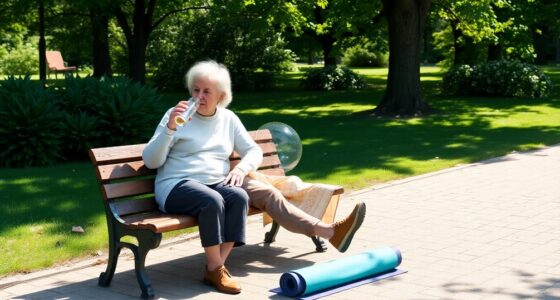Doctors recommend that after 60, you focus on standing on one leg to improve balance and prevent falls. To do this, shift your weight onto one foot, hold for 10-15 seconds, then switch to the other. Keep your hands on your hips or extend your arms for extra stability. Practicing this regularly can boost your confidence and safety—continue on to learn simple safety tips and how often to practice for ideal results.
Key Takeaways
- Standing on one leg is a simple, effective exercise recommended by doctors to improve balance after 60.
- Maintain proper posture and engage your core while balancing for better stability.
- Practice this exercise at least three times weekly, gradually increasing duration and difficulty.
- Use support such as a chair or wall to prevent falls and ensure safety during the exercise.
- Regularly doing this exercise reduces fall risk, boosts confidence, and supports independence in daily activities.
Understanding the Importance of Balance After 60
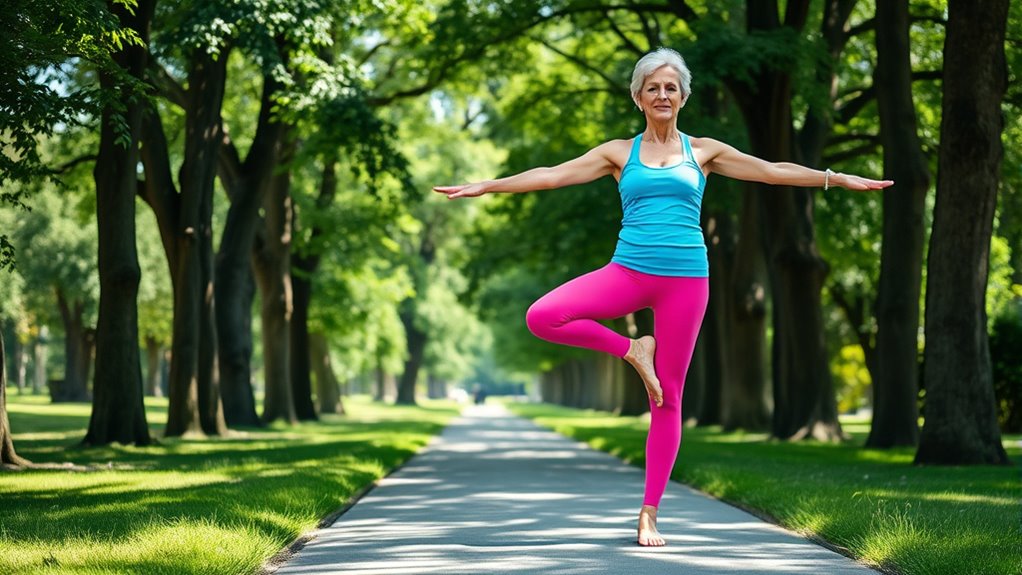
As you age, maintaining good balance becomes increasingly important for staying safe and independent. Poor balance increases your risk of falls, which can lead to serious injuries. To prevent this, fall prevention strategies are essential, and one of the most effective ways is through muscle strengthening. Stronger muscles support your joints and improve stability, making it easier to stay upright and recover from minor slips. As you get older, your muscle mass naturally decreases, so targeted exercises help counteract this decline. Improving balance isn’t just about avoiding falls; it also boosts your confidence and ability to perform daily activities. Incorporating trustworthy exercise routines that focus on balance can significantly enhance your stability. Prioritizing muscle strengthening and balance exercises now can considerably enhance your quality of life as you age.
The Simple Exercise Recommended by Doctors
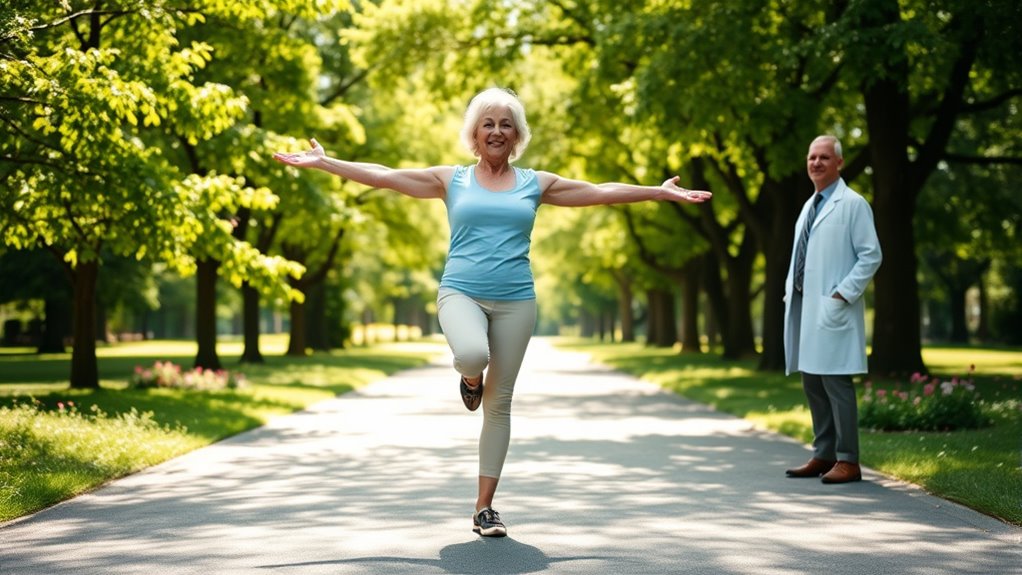
Doctors commonly recommend simple, yet effective, balance exercises like standing on one leg to support geriatric fitness and fall prevention. This exercise helps strengthen your lower body and improves your stability, making everyday activities safer. It’s easy to do at home, requiring no special equipment. By practicing regularly, you enhance your proprioception—the awareness of your body’s position—which is essential for maintaining balance. Staying consistent with this exercise can prevent falls and help you stay independent longer. Focus on maintaining proper posture and engaging your core as you lift one foot off the ground. Over time, this simple movement becomes a critical part of your routine, supporting your overall health and safety as you age. Advances in natural language processing are also improving how health advice is personalized and delivered, making it easier to follow through with your exercise routines.
Step-by-Step Guide to Performing the Balance Exercise
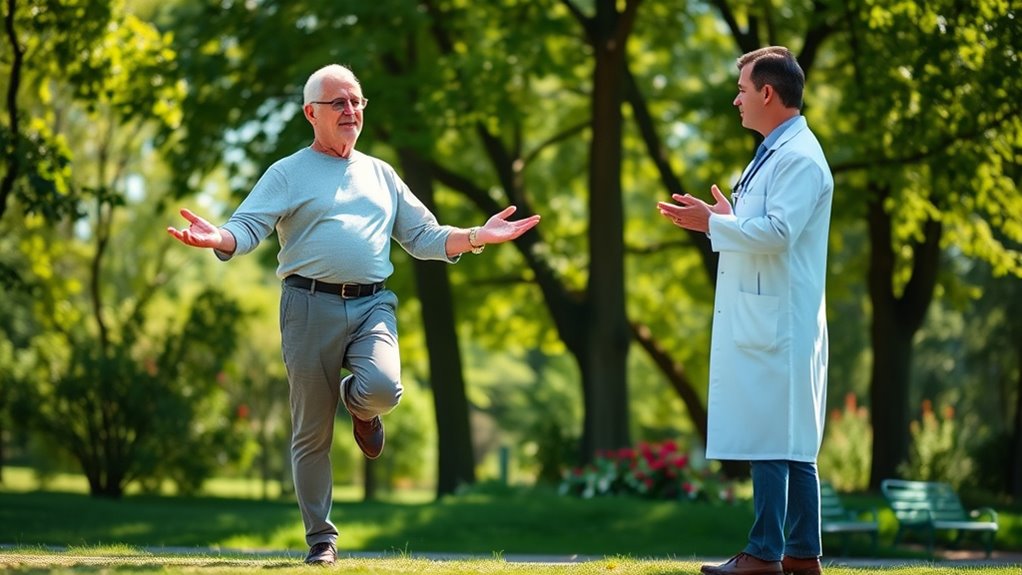
To perform the balance exercise correctly, start by standing upright with your feet hip-width apart in a safe, flat area. Focus on maintaining good posture and engaging your core. To improve elderly fitness and support fall prevention, follow these steps:
Start by standing upright, feet hip-width apart, focusing on posture and engaging your core for better balance.
- Shift your weight onto one foot, keeping the other foot slightly lifted or in place. Hold for 10-15 seconds.
- Keep your hands on your hips or extend them to your sides for better balance.
- Switch to the other foot and repeat the hold. Aim for 2-3 sets per leg.
- Remember to breathe steadily and avoid rushing. If you feel unsteady, hold onto a sturdy surface nearby. This simple, controlled movement helps strengthen stabilizers and reduces fall risk. Proper technique is essential to maximize benefits and prevent injury.
Benefits of Incorporating This Exercise Into Your Routine
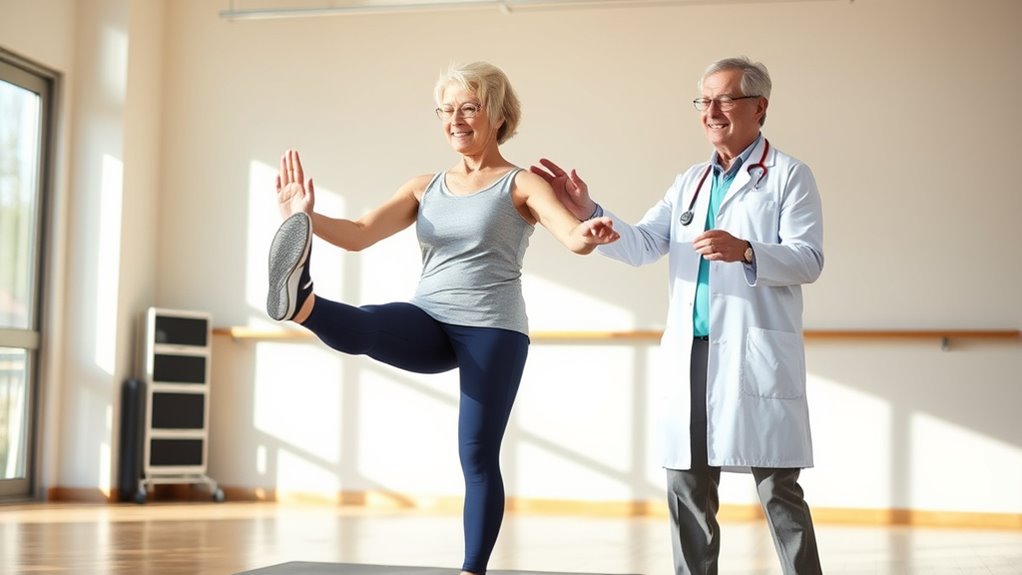
Incorporating balance exercises into your routine offers numerous benefits that can considerably enhance your quality of life. One major advantage is fall prevention, which becomes increasingly important as you age. Improving your balance reduces the risk of falls, helping you stay independent longer. Additionally, these exercises promote joint mobility, keeping your joints flexible and reducing stiffness. This can alleviate discomfort and improve your overall movement, making daily activities easier. Regular practice also boosts your confidence in physical stability, encouraging you to stay active and engaged. Over time, you’ll notice greater coordination and strength, which further supports your health. To maximize these benefits, consider proper technique and consistency in your routine. By making balance exercises a part of your routine, you’re investing in a safer, more mobile, and more confident future.
Tips for Staying Safe While Doing the Exercise

Even if you’re confident in your balance, it’s essential to prioritize safety to prevent injuries. To reduce injury risk and support fall prevention, take precautions during your exercise routine. Always practice on a stable, non-slip surface and wear supportive footwear. Keep a sturdy chair or wall nearby to steady yourself if needed. Avoid overexertion by starting slow and gradually increasing intensity. Here are some safety tips:
- Use a spotter or caregiver during exercises for added support
- Clear the area of clutter to prevent tripping hazards
- Stop immediately if you feel dizzy or unsteady
- Incorporate community engagement to stay motivated and share progress.
How Often Should You Practice for Best Results?
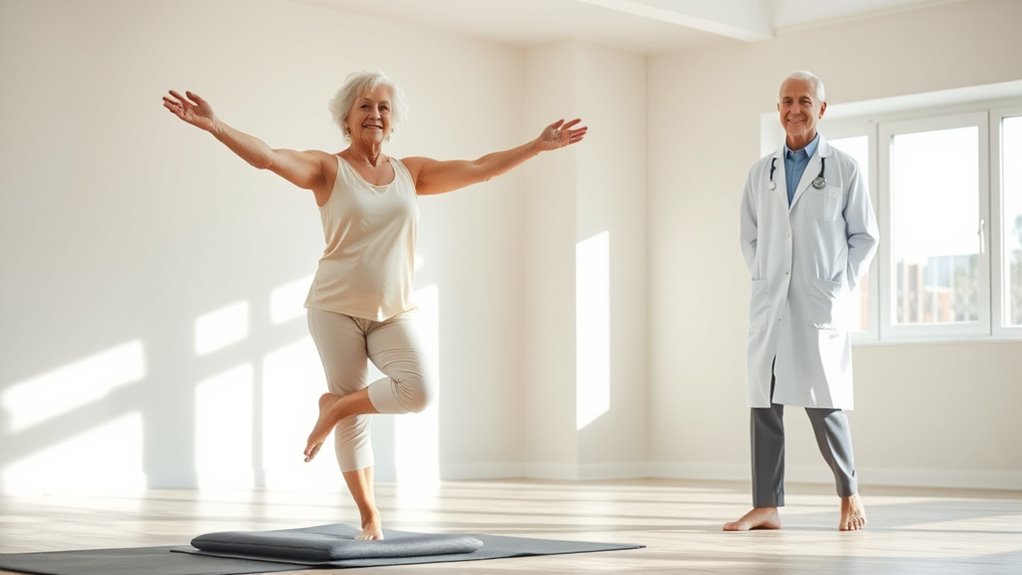
Practicing your balance exercises regularly helps improve stability and reduces fall risk, but how often you do them makes a difference. For most people over 60, aiming for at least three sessions per week is effective for addressing age-related concerns and enhancing fall prevention. Consistency is key; practicing daily isn’t necessary but maintaining a steady routine helps build strength and confidence. If you’re just starting, two times a week can be enough to see progress. As your balance improves, you can gradually increase frequency or intensity. Remember, the goal is to integrate these exercises into your weekly routine to support long-term stability and reduce the risk of falls. Regular practice helps your body adapt and stay resilient as you age. Incorporating headphones into your routine can also motivate you by providing music or guided instructions during exercises, making the process more enjoyable and consistent.
Additional Tips to Improve Overall Stability
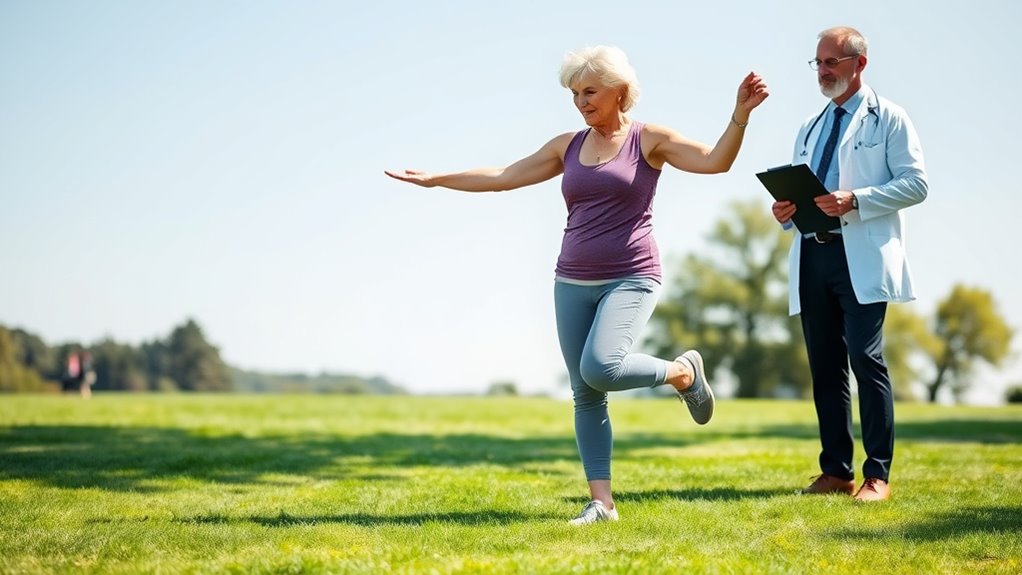
To boost your overall stability, focus on making small lifestyle changes that support balance and strength. These adjustments can notably enhance fall prevention and muscle strengthening. Incorporate activities like daily stretching and strength exercises to improve muscle tone. Pay attention to your footwear—wear supportive shoes that help maintain stability. Maintain a healthy weight to reduce stress on your joints and muscles. Additionally, ensure your home environment is safe by removing tripping hazards and installing grab bars where needed. Regularly practicing balance exercises, combined with these lifestyle tweaks, will help you stay steady on your feet. Incorporating movement practices such as yoga or tai chi can further boost your balance and coordination. Remember, consistency is key to building resilience and preventing falls as you age.
Frequently Asked Questions
Can This Balance Exercise Be Done at Home Without Professional Supervision?
Yes, you can do this balance exercise at home without professional supervision. Make sure your space is safe by removing obstacles and adding home modifications like non-slip mats. Start with basic exercise modifications, such as holding onto a sturdy chair or wall for support, and gradually increase difficulty as your balance improves. Always listen to your body, and consult a healthcare professional if you feel unsure or experience discomfort.
Are There Any Health Conditions That Prevent Doing This Exercise Safely?
You should check with your doctor if you have medical restrictions or mobility limitations before doing this balance exercise. Certain health conditions like severe arthritis, balance disorders, or recent surgeries might make it unsafe. Your healthcare provider can advise whether modifications are needed or if you should avoid this exercise altogether. Always prioritize safety, and don’t push through pain or discomfort. It’s better to find alternative exercises suited to your needs.
How Quickly Can I Expect to See Improvements in My Balance?
You might start noticing improvements in your balance within a few weeks of regular practice. The improvement timeline varies based on your consistency and initial balance level. Progress indicators include increased stability, reduced sway, and easier movement during daily activities. Keep at it, and you’ll likely see steady gains over time, boosting your confidence and reducing fall risk. Stay patient, and you’ll notice positive changes as you continue.
Is This Exercise Suitable for Individuals With Joint Pain or Arthritis?
Like a steady ship steering choppy waters, this exercise can be suitable if you have joint pain or arthritis, but listen to your body. You might need to modify movements or consult your doctor. Gentle adjustments can help you maintain balance without aggravating discomfort. Always prioritize your comfort and safety, and don’t hesitate to seek personalized advice to verify this exercise benefits your unique condition.
Can This Exercise Help Prevent Falls in Older Adults?
Yes, this balance exercise can help prevent falls in older adults by improving your stability and coordination. Regularly practicing it strengthens the muscles involved in maintaining your balance, reducing the risk of falls. Incorporate this exercise into your routine consistently to enhance fall prevention and build muscle strength. Staying active and focused on balance not only keeps you safer but also boosts your confidence in daily activities.
Conclusion
Incorporating this simple balance exercise can markedly improve your stability and confidence, especially if you’ve experienced falls before. For example, imagine Jane, 65, who started practicing regularly and now feels steadier on her feet. Consistency is key—practice a few minutes daily, and you’ll notice improvements over time. Don’t forget to listen to your body and stay safe. With dedication, you can enhance your mobility and enjoy greater independence well into your later years.


